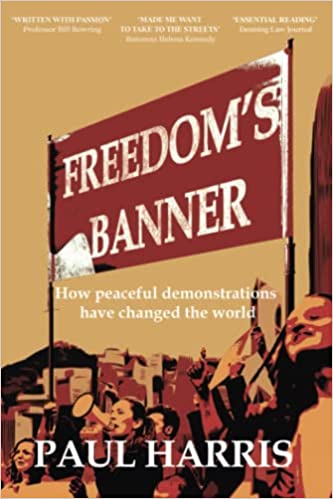*/
By Paul Harris

CRUX PUBLISHING (MARCH 2022)
PAPERBACK, 358 PAGES
Paul Harris is a very brave man. He burnished the banner of freedom in Hong Kong where he was Chair of the Hong Kong Bar Association until January 2022. In March 2022 he was bundled to a meeting with national security police. He then wisely left for England where he is a member of Doughty Street Chambers.
Harris would not comment as to the reason for his being summoned but we know that he was representing two former assembly members in the so-called ‘47 democrats’ case. He had also said that the new national security legislation insisted on by the Chinese government was inconsistent with the Basic Law, Hong Kong’s constitution. Harris had received repeated serious threats of arrest from official sources if he did not resign and leave before the end of his term, and was determined to avoid doing so. It is thus appropriate that Harris’ book is called Freedom’s Banner. Its subtitle is How peaceful demonstrations have changed the world.
The book relates in around 350 pages the history of peaceful demonstrations, riots, rebellions and revolutions across the world. He dates the peaceful political march or assembly to the end of the 18th century from when it proved to be ‘startingly successful’. For example, without the demonstrations of the ‘days of May’ in 1832, England would not have become a democracy when it did. It was also in that decade when the word ‘demonstrations’ entered the vocabulary.
This may be contrasted with the demonstrations with which the book ends, the mass protests in China. I had not realised that the Tiananmen Square protests in 1989 garnered no fewer than 1.2 million protestors. These were spontaneous, unlike the demonstrations during the Cultural Revolution which Harris tells us ‘were Mao’s way of preserving himself in power after the catastrophe of the “Great Leap Forward”’.
He considers with care the tension between those marches which want to stay within the law and those where demonstrators deliberately set out to break it. He also considers demonstrations organised through social media networking sites, in particular in the Arab Spring and police tactics such as kettling.
There is nothing dry about this book. It proceeds at pace from the London Corresponding Society, Peterloo to the Suffragettes, by way of Gandhi with valuable chapters on the law of demonstrations and what makes a successful demonstration. Many such campaigns did not succeed at first but only after long periods.
For those who want to protest, Freedom’s Banner is a stirring and necessary read.

CRUX PUBLISHING (MARCH 2022)
PAPERBACK, 358 PAGES
Paul Harris is a very brave man. He burnished the banner of freedom in Hong Kong where he was Chair of the Hong Kong Bar Association until January 2022. In March 2022 he was bundled to a meeting with national security police. He then wisely left for England where he is a member of Doughty Street Chambers.
Harris would not comment as to the reason for his being summoned but we know that he was representing two former assembly members in the so-called ‘47 democrats’ case. He had also said that the new national security legislation insisted on by the Chinese government was inconsistent with the Basic Law, Hong Kong’s constitution. Harris had received repeated serious threats of arrest from official sources if he did not resign and leave before the end of his term, and was determined to avoid doing so. It is thus appropriate that Harris’ book is called Freedom’s Banner. Its subtitle is How peaceful demonstrations have changed the world.
The book relates in around 350 pages the history of peaceful demonstrations, riots, rebellions and revolutions across the world. He dates the peaceful political march or assembly to the end of the 18th century from when it proved to be ‘startingly successful’. For example, without the demonstrations of the ‘days of May’ in 1832, England would not have become a democracy when it did. It was also in that decade when the word ‘demonstrations’ entered the vocabulary.
This may be contrasted with the demonstrations with which the book ends, the mass protests in China. I had not realised that the Tiananmen Square protests in 1989 garnered no fewer than 1.2 million protestors. These were spontaneous, unlike the demonstrations during the Cultural Revolution which Harris tells us ‘were Mao’s way of preserving himself in power after the catastrophe of the “Great Leap Forward”’.
He considers with care the tension between those marches which want to stay within the law and those where demonstrators deliberately set out to break it. He also considers demonstrations organised through social media networking sites, in particular in the Arab Spring and police tactics such as kettling.
There is nothing dry about this book. It proceeds at pace from the London Corresponding Society, Peterloo to the Suffragettes, by way of Gandhi with valuable chapters on the law of demonstrations and what makes a successful demonstration. Many such campaigns did not succeed at first but only after long periods.
For those who want to protest, Freedom’s Banner is a stirring and necessary read.
By Paul Harris


Chair of the Bar reflects on 2025
AlphaBiolabs has donated £500 to The Christie Charity through its Giving Back initiative, helping to support cancer care, treatment and research across Greater Manchester, Cheshire and further afield
Q&A with criminal barrister Nick Murphy, who moved to New Park Court Chambers on the North Eastern Circuit in search of a better work-life balance
Revolt Cycling in Holborn, London’s first sustainable fitness studio, invites barristers to join the revolution – turning pedal power into clean energy
Rachel Davenport, Co-founder and Director at AlphaBiolabs, reflects on how the company’s Giving Back ethos continues to make a difference to communities across the UK
By Marie Law, Director of Toxicology at AlphaBiolabs
Are you ready for the new way to do tax returns? David Southern KC explains the biggest change since HMRC launched self-assessment more than 30 years ago... and its impact on the Bar
Professor Dominic Regan and Seán Jones KC present their best buys for this holiday season
Marking one year since a Bar disciplinary tribunal dismissed all charges against her, Dr Charlotte Proudman discusses the experience, her formative years and next steps. Interview by Anthony Inglese CB
Little has changed since Burns v Burns . Cohabiting couples deserve better than to be left on the blasted heath with the existing witch’s brew for another four decades, argues Christopher Stirling
Pointillism, radical politics and social conscience. Review by Stephen Cragg KC